
Graphite pencil on Illustration Board. 48 x 25 inches. This is the full sized pencil drawing for the finished painting now in the collection of John Mecom, Jr. The subject matter is famed racing driver Wilbur Shaw staving off one of his rivals. In this case, Charles "Dutch" Bauman. This work is fully matted and framed. (private collection). #60
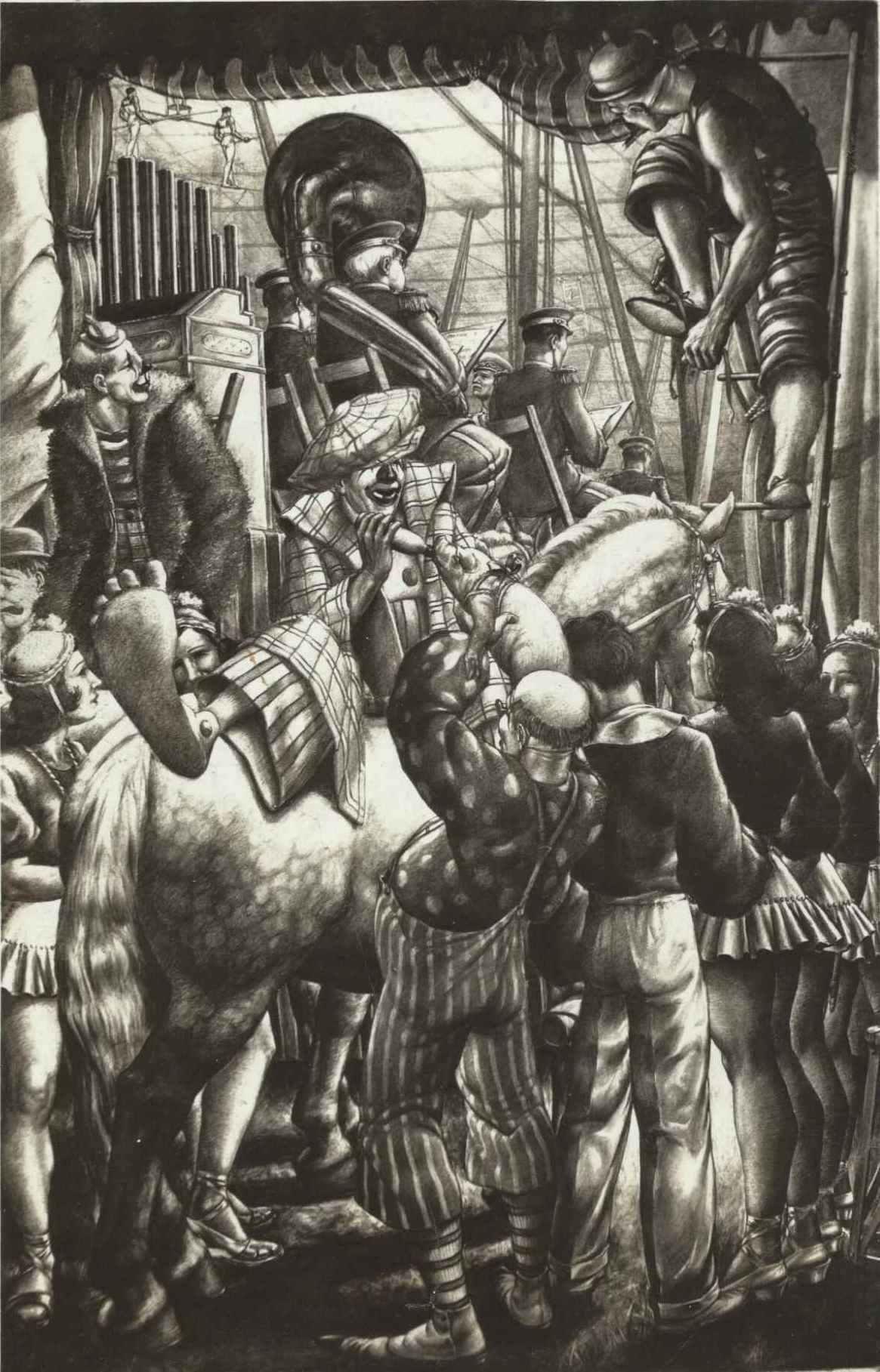
Graphite pencil/charcoal on board. 58.125 x 40.125 inches. Full size drawing for the fully realized painting that tied for first place in the 1937 Chaloner Prize competition. #39

Graphite on paper, 30.5” x 22.625” signed R. Weaver lower right. This drawing was for the recently rediscovered painting by REW is typical of his style post WWII. The subjects on horseback are most likely Edwin “Poodles” Hanneford and his daughter Gracie. The composition perfectly illustrated his youthful enthusiasm for the illustrating the circus of the 1930s and early 40s. See the finished painting in the painting menu. (private collection of Philip Keller)

Graphite pencil on paper. 10 x 15 inches. Signed lower right R. Weaver. Unframed, matted and shrink wrapped. Nothing on the circus lot was more exciting to REW than watching the great Big Top go up. Here five workers, lead by the Boss Canvas Man, raise side poles, and fix the lines to stakes. #396

Graphite on paper, mounted on foam board. 38” x 29,” signed R. Weaver lower left. Perhaps one of the last large drawings completed by REW before his passing in 1991. John Bill Ricketts is considered to be the father of the American circus. He was the first in the United States to combine equestrian, acrobats, trained animals, and clowns in one show. Ricketts’ circus opened on April 3, 1793 with President George Washington in attendance. #192
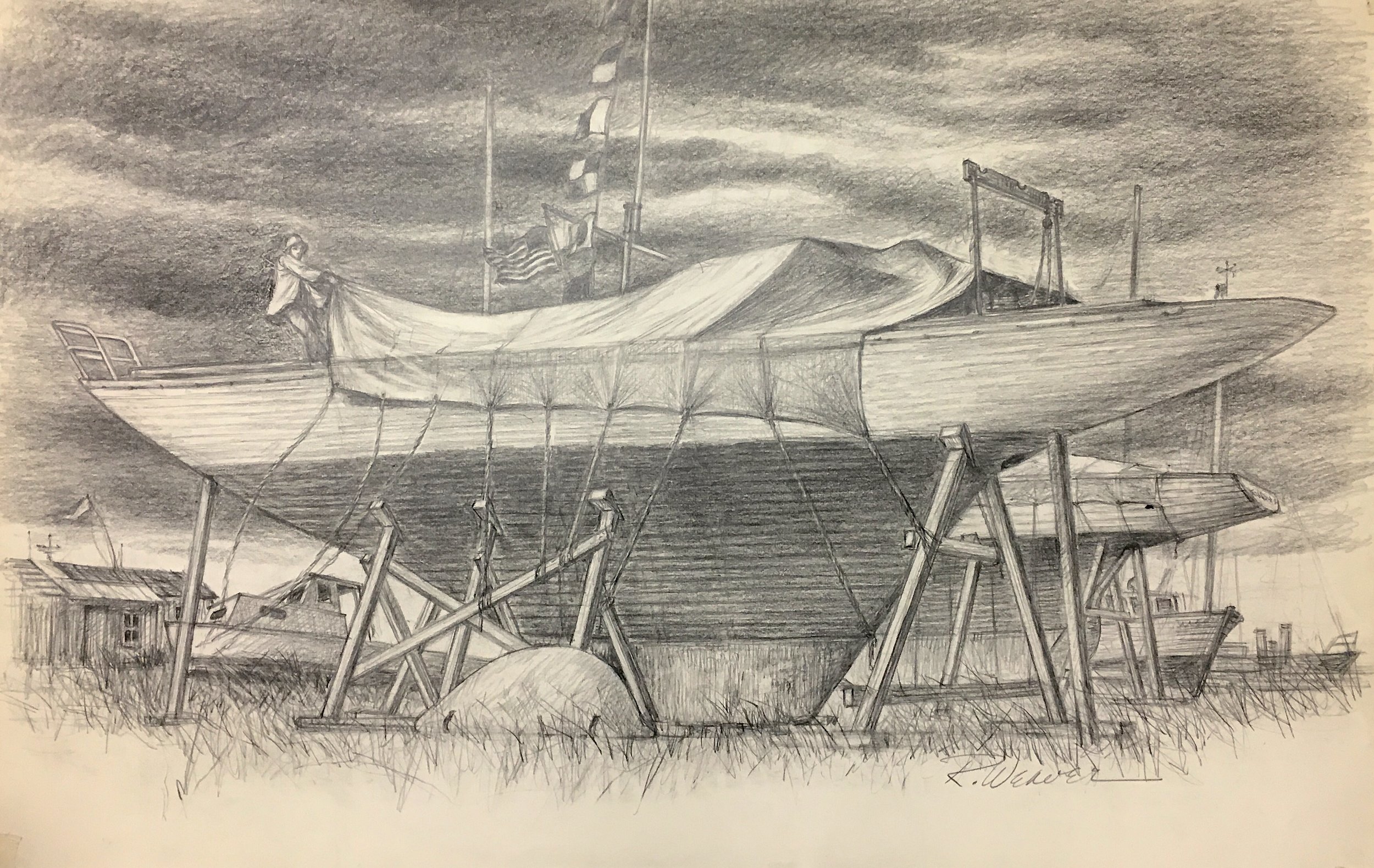
Graphite, on paper. 11 inches x 14 inches. Signed R. Weaver lower right. Once in a while REW would deviate from his usual subject matter to illustrate a moment or event. One of those events was the visit by hurricane Gloria in 1985, one of his first years living in North Carolina. This drawing was a study for the final painting. The painting sold but this drawing is still available for purchase. W84A

Lithograph print on cover stock paper. In the mid-1970s, REW produced limited edition prints of some of the great circus wagons of the early days of the traveling shows. They were referred to as
”Cottage Wagons” because of their ornate decoration, including bays, and ornate roof decorations. Copies of this print are available for purchase.
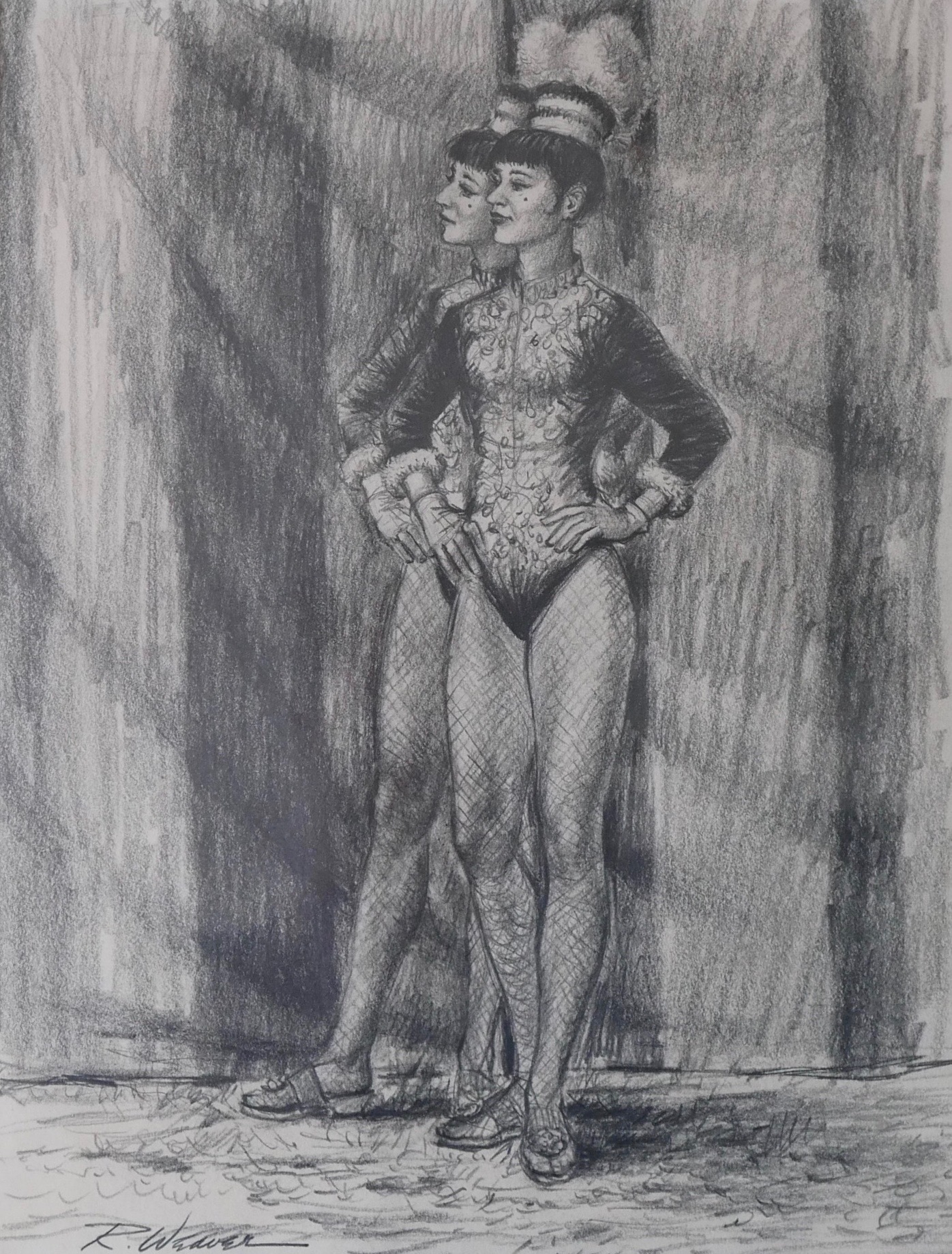
Graphite pencil on paper. Signed R. Weaver lower left. #217

Graphite pencil on illustration board. Signed R. Weaver lower right. REW was known for his drafting skills. His knowledge of anatomy was so sound that he rarely if ever used models beyond school. #W81
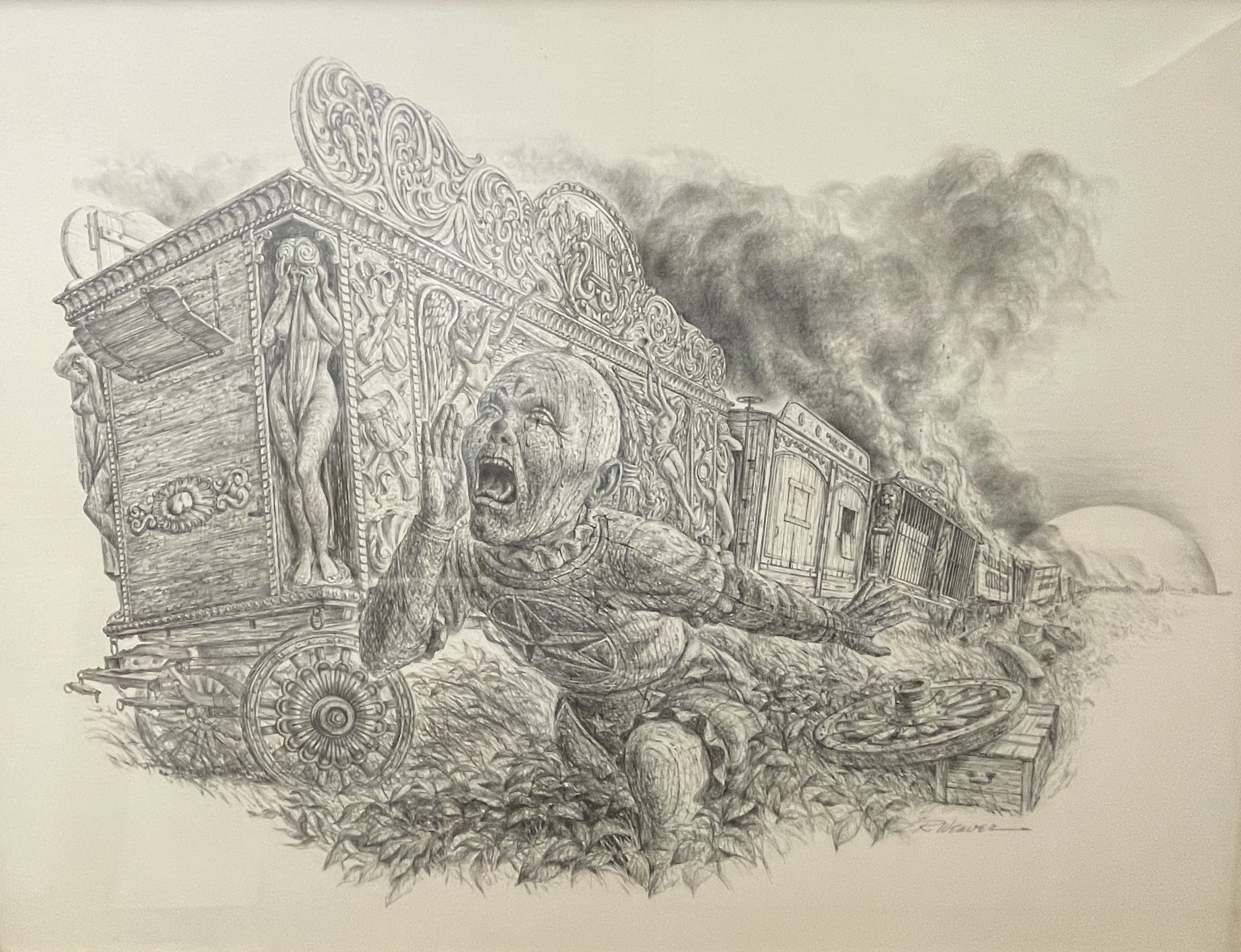
Graphite pencil on board. #W178
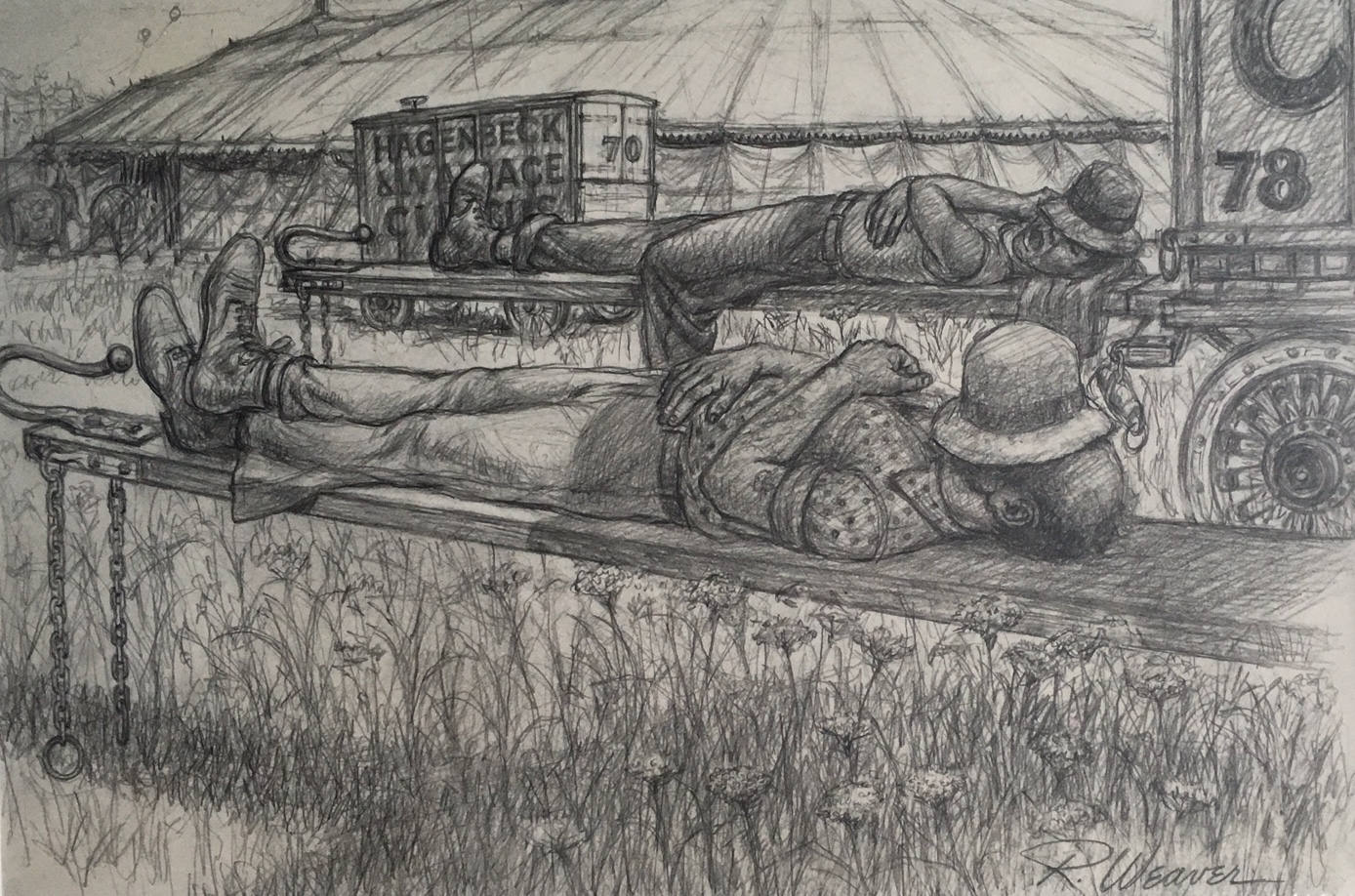
Graphite on paper. 10.5 x 14.75 inches. Matted and signed R. Weaver lower right. Exhausted "roustabouts" nap on the tongue of wagons. The tongue was the piece of equipment that horses were hitched to to pull the great circus wagons to there destinations. #403 (private collection)

Graphite pencil on paper. 13 x 9.25 inches. Signed R. Weaver lower left. Unframed, matted, and shrink wrapped. The blacksmith helped to keep everything running on the circus compound. The forge ran endlessly during the circus's stay in any town. Of course, he always had time for a beautiful performer that might stroll by. #422

Graphite on illustration board. Signed R. Weaver lower right. The subject is self explanatory and demonstrates REW’s great ability as an illustrator. Represented by James R. Ross Fine Art #158

Graphite on card stock, 11 x 14.125 inches, unsigned, estate stamped on the reverse side. Matted. A principal figure on any traveling circus was the Side Show barker. The barker's combination of wit and oratory guided patrons to the Side Show to see and experience the unusual. This is an early work by REW that demonstrates his great sense of figural composition.
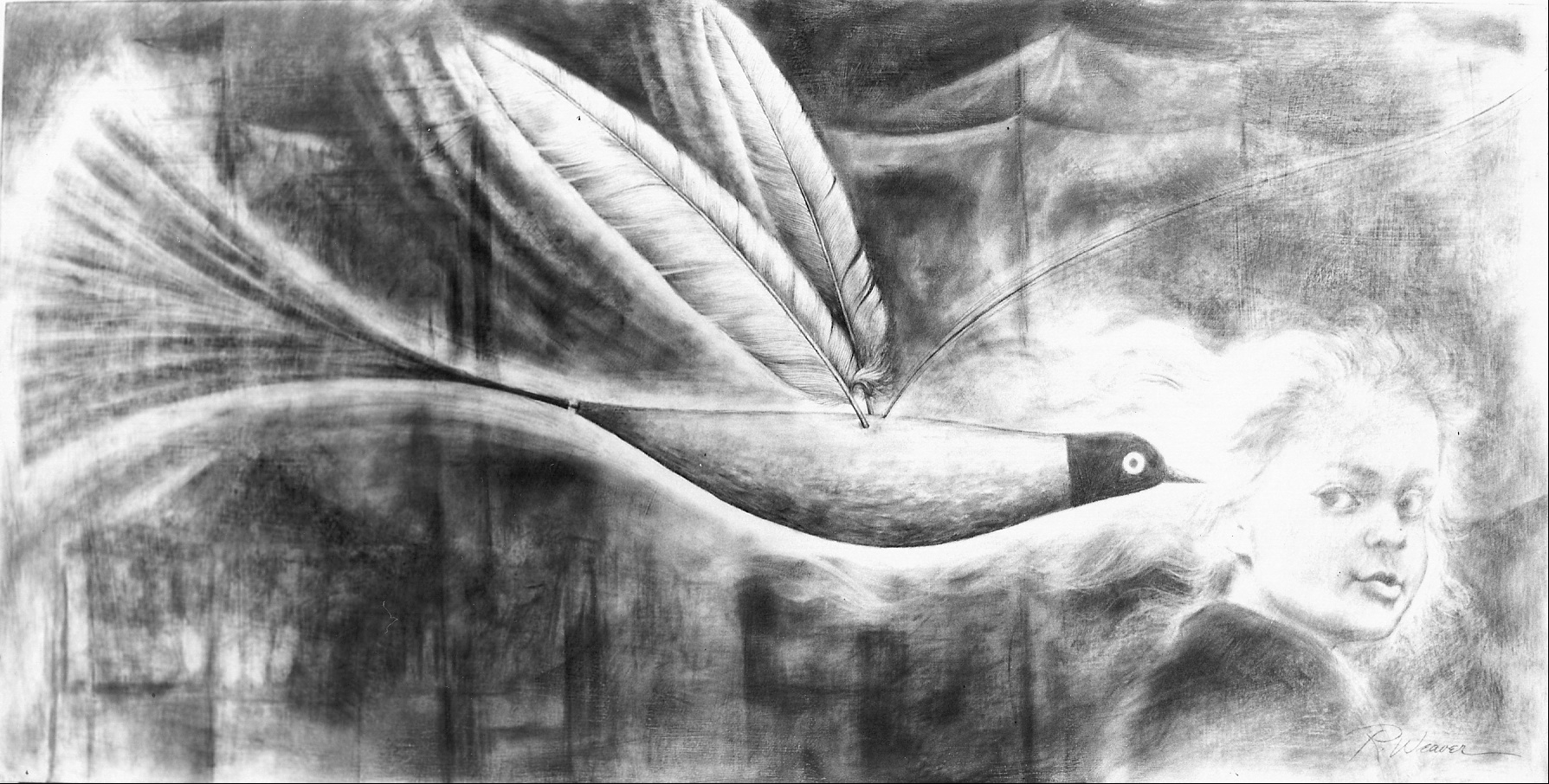
Graphite pencil on Illustration board. This image captures the fascination of the young girl with a favorite souvenir from the circus. #150

Graphite pencil on paper. Never straying too far from his love of circus, REW made this study of an aerialist in his dressing tent. It is very similar in composition to his "Circus Girl In Her Dressing Tent." (see paintings on this website) The subject here is Robert Porter, one of the great circus horizontal bar artists of his time. #597

Artist pencil on paper. Unframed, unsigned, matted in shrink wrap. Estate stamp on reverse. 8 x 13 inches. This early study by REW looks at a midwestern fair ground, and one of its more popular competitions. The horse pull. The study illustrates the power of equines guided by their equally strong master. REW had a great affinity for equestrian subjects both circus and civilian. #392
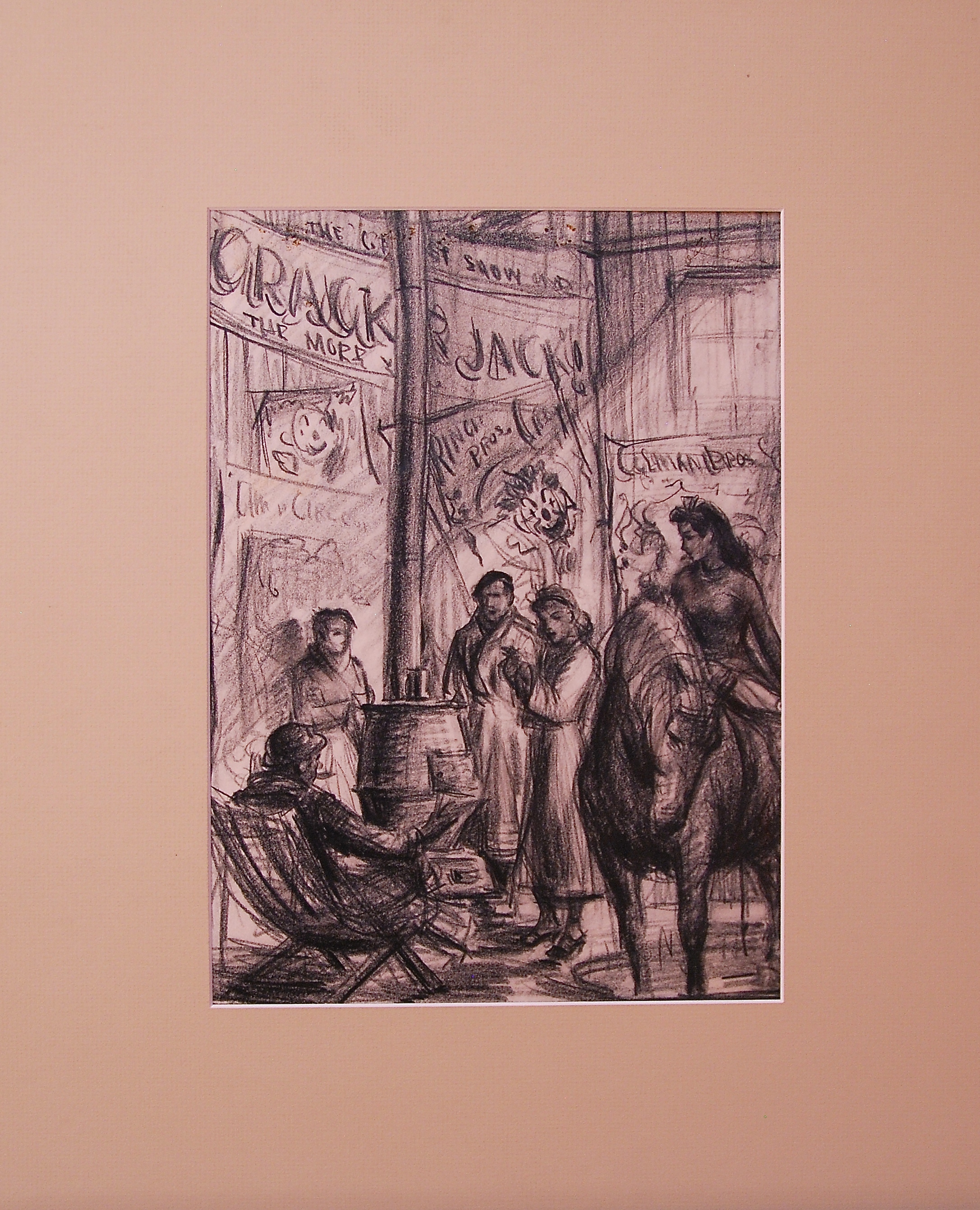
Graphite pencil, on paper. unsigned. 13"x 9 3/4." Circus performers gather around a stove in a rehearsal barn amidst the banners. Fully matted and framed in American chestnut 22 5/8"x 19 1/8." #225

Graphite pencil on paper. 12.5 x 10.5 inches. Signed R. Weaver lower right. Unframed, matted, and shrink wrapped. Circus roustabouts rest on hay bales waking to the cookhouse smoke. Sometimes food and a place to sleep were the pay on the traveling circus. #270
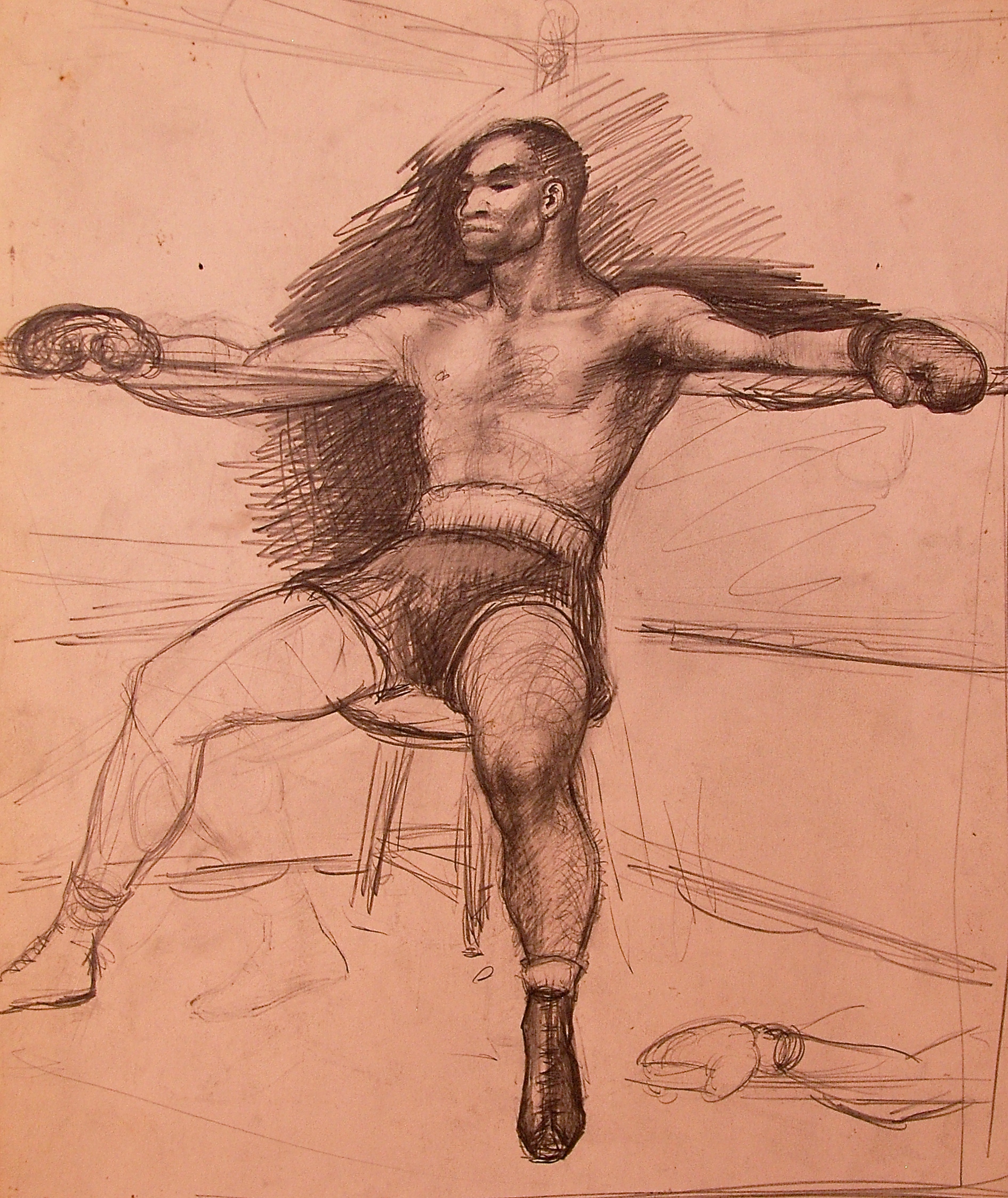
Early study by Robert Edward Weaver. Possibly Joe Louis. (unsigned) #606
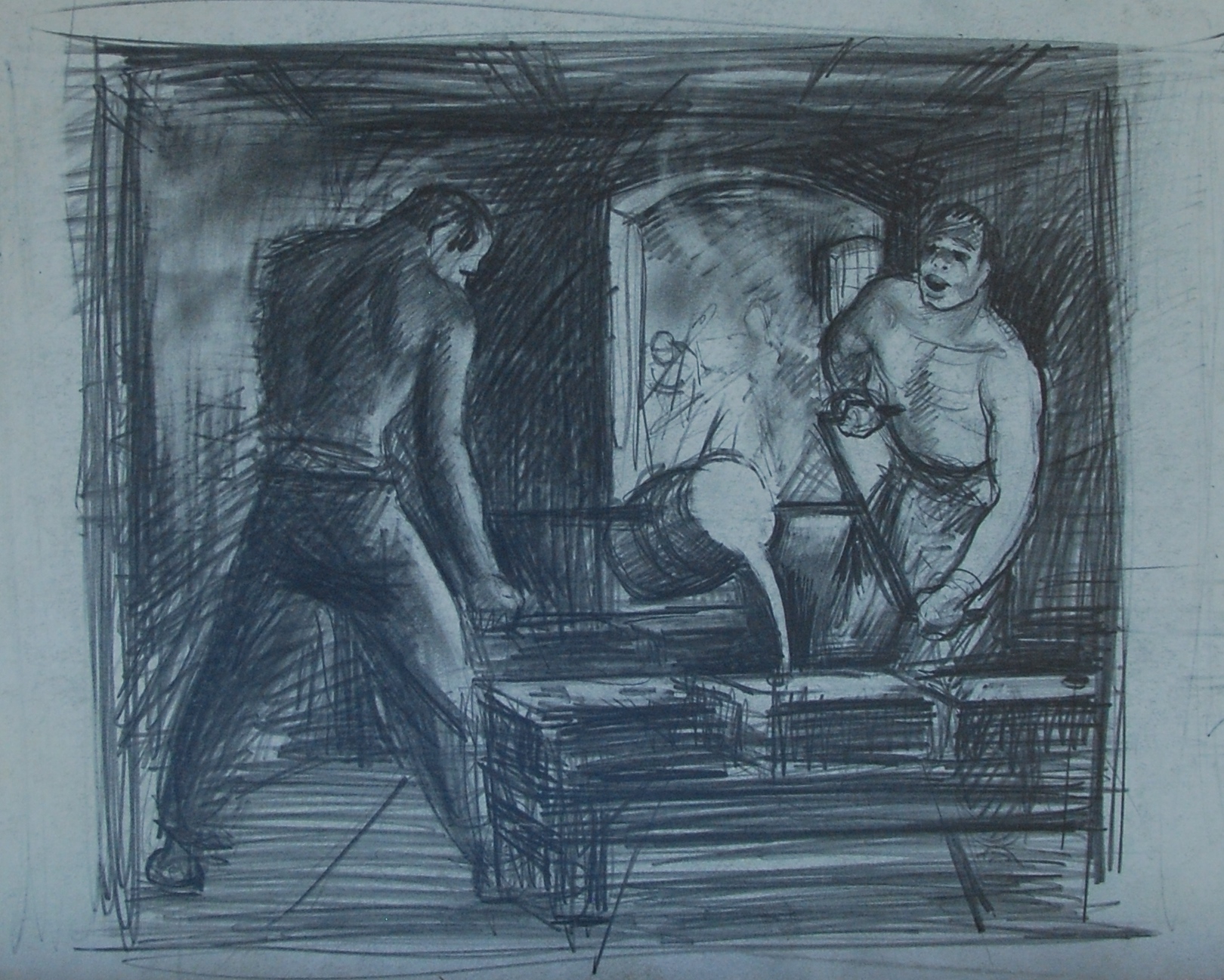
Unsigned early work by Robert Edward Weaver. #621A
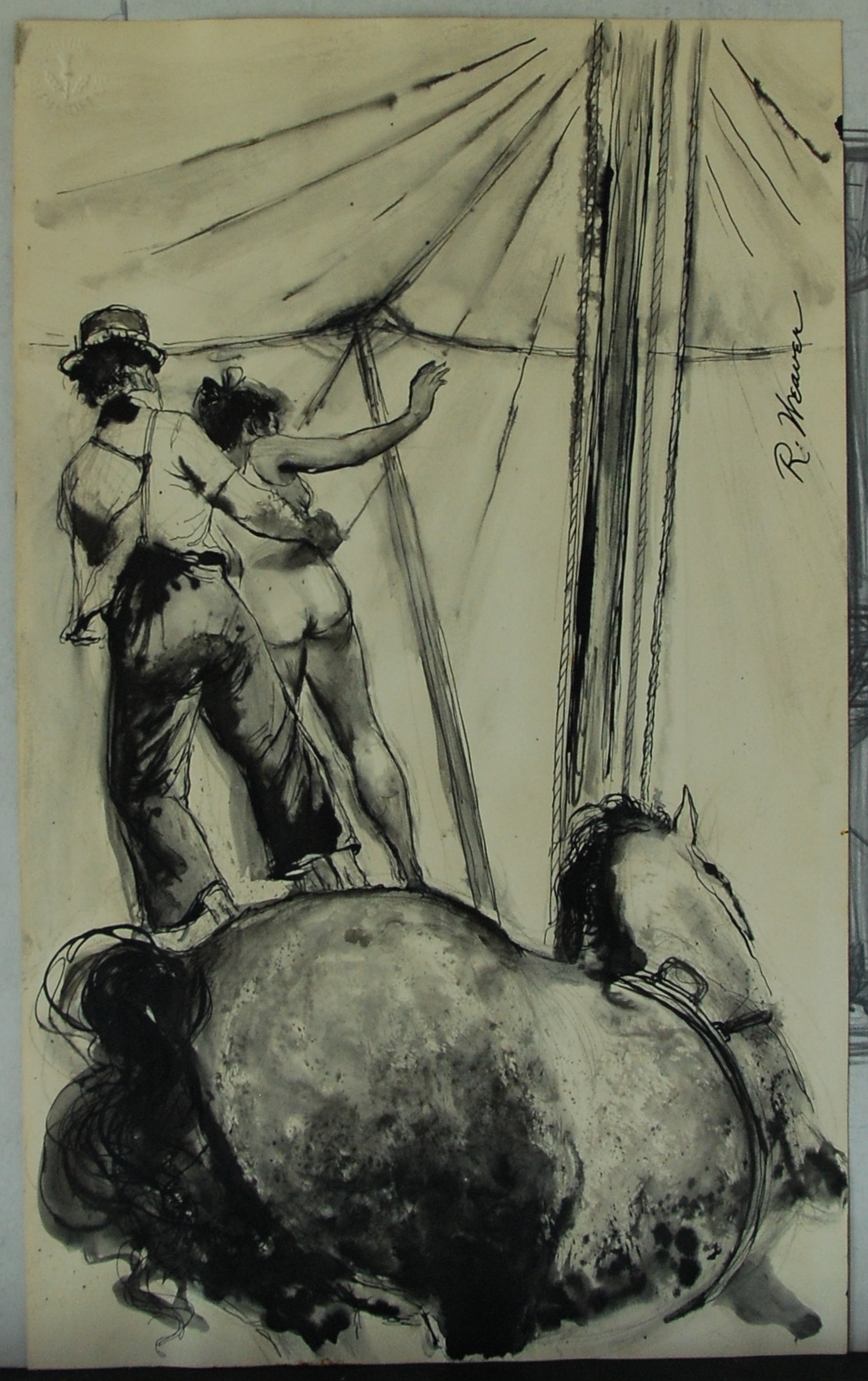
Graphite pencil and ink guache on paper. #571
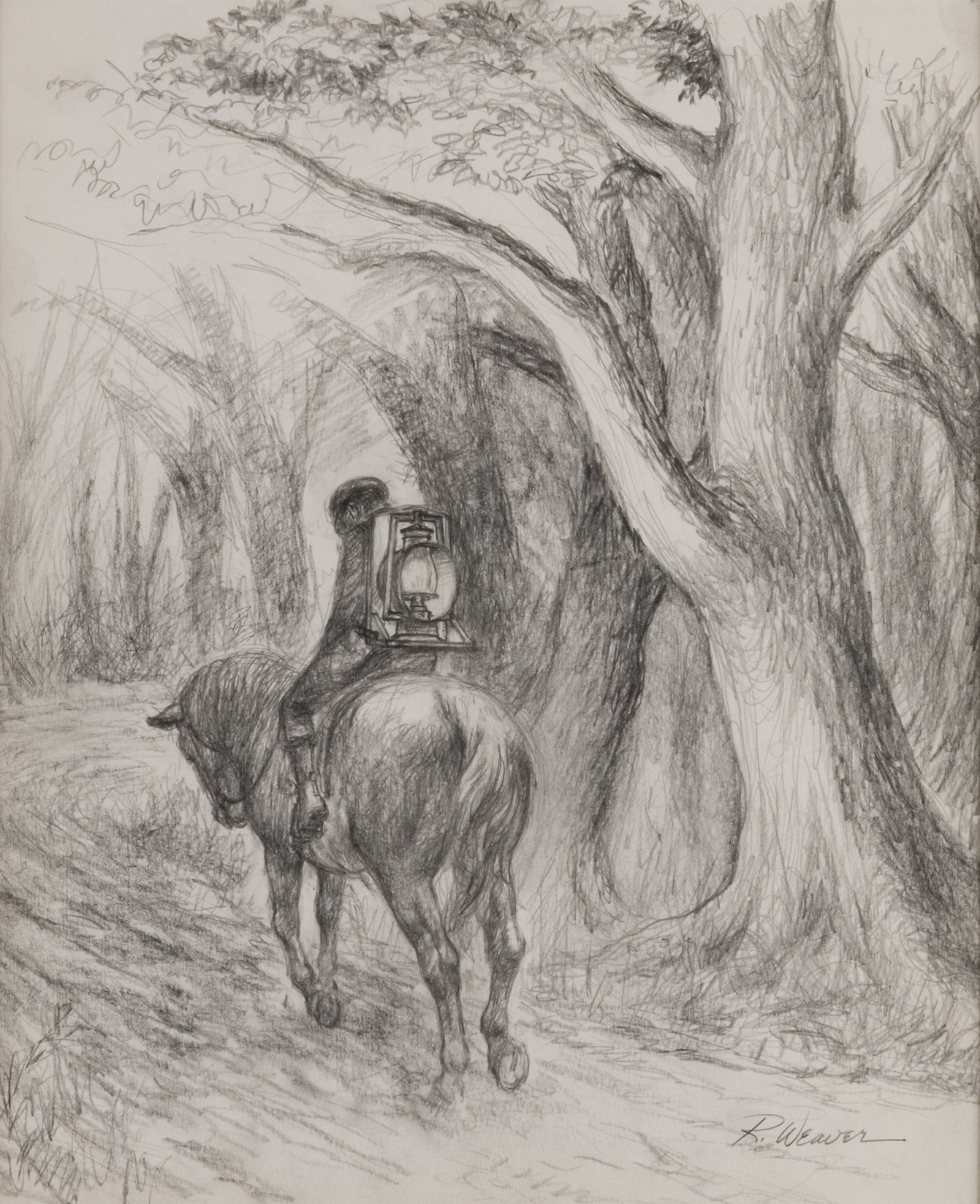
Graphite pencil on illustration board.

Graphite pencil on illustration board. A work of whimsy by REW. During the mid-1970's REW was working on ideas for a children's book. This was one of the many puny images that REW concocted out of his fertile brain at the time.
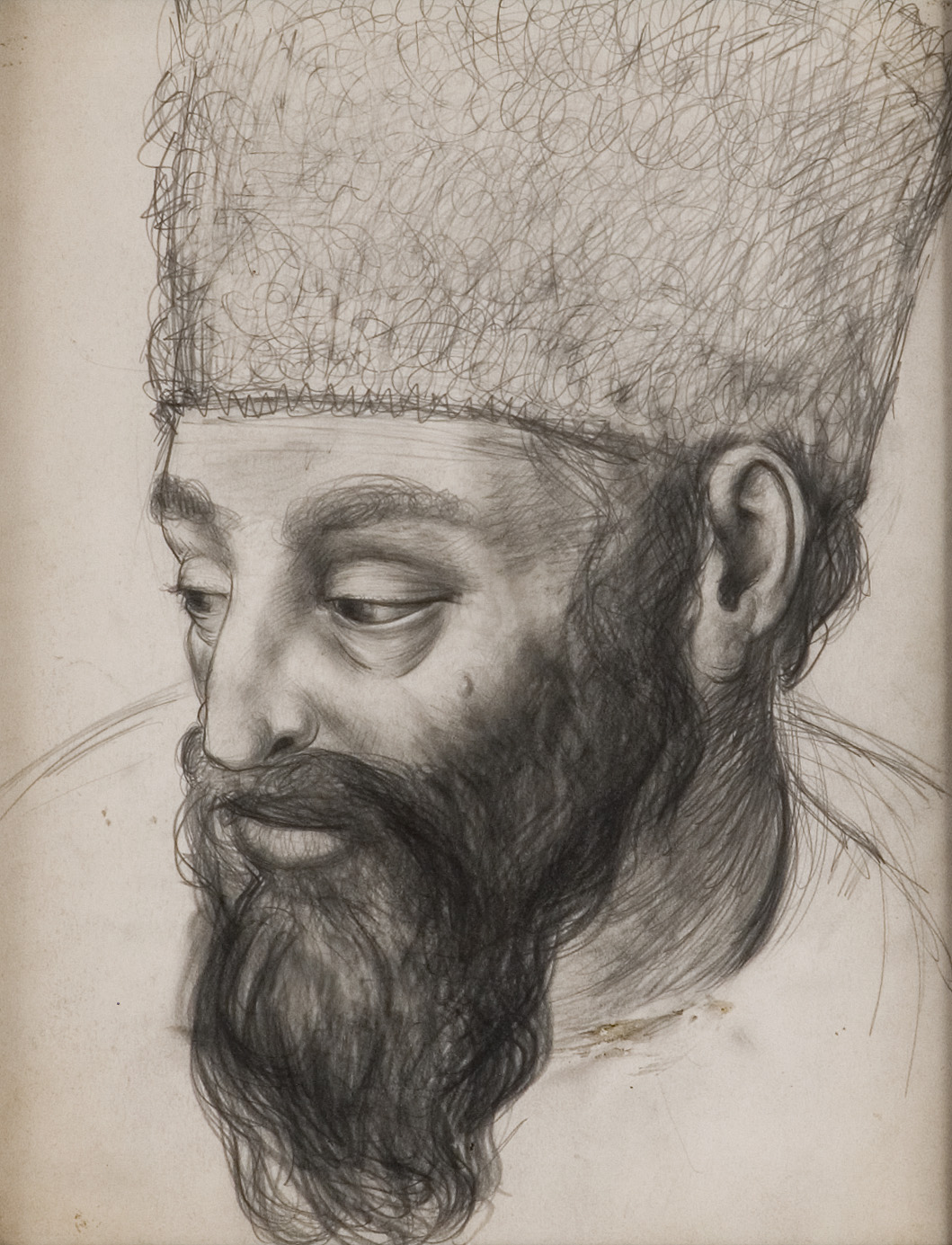
Graphite pencil on heavy stock. (unsigned)
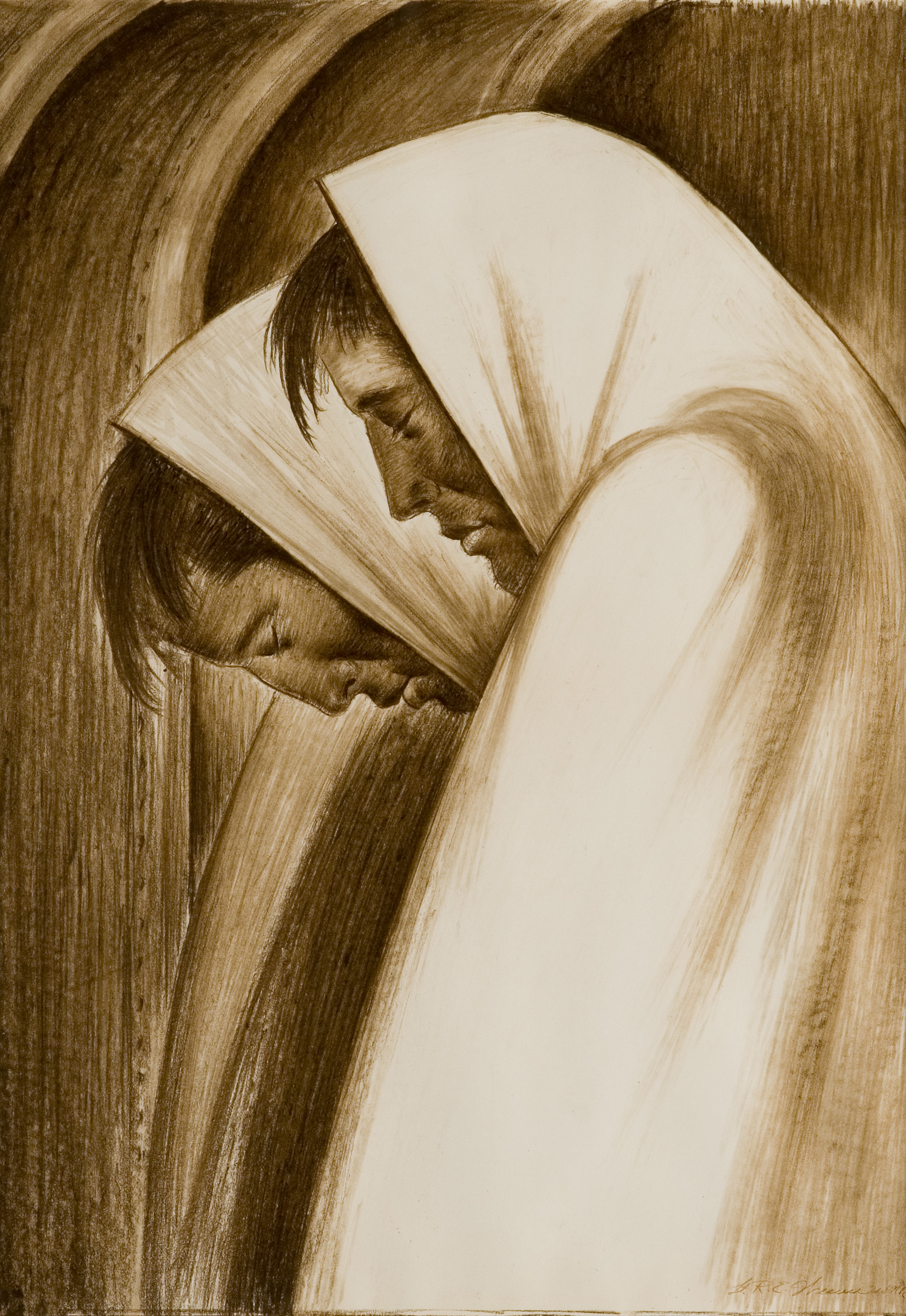
Another rare work from WWII by Robert Edward Weaver. #W232
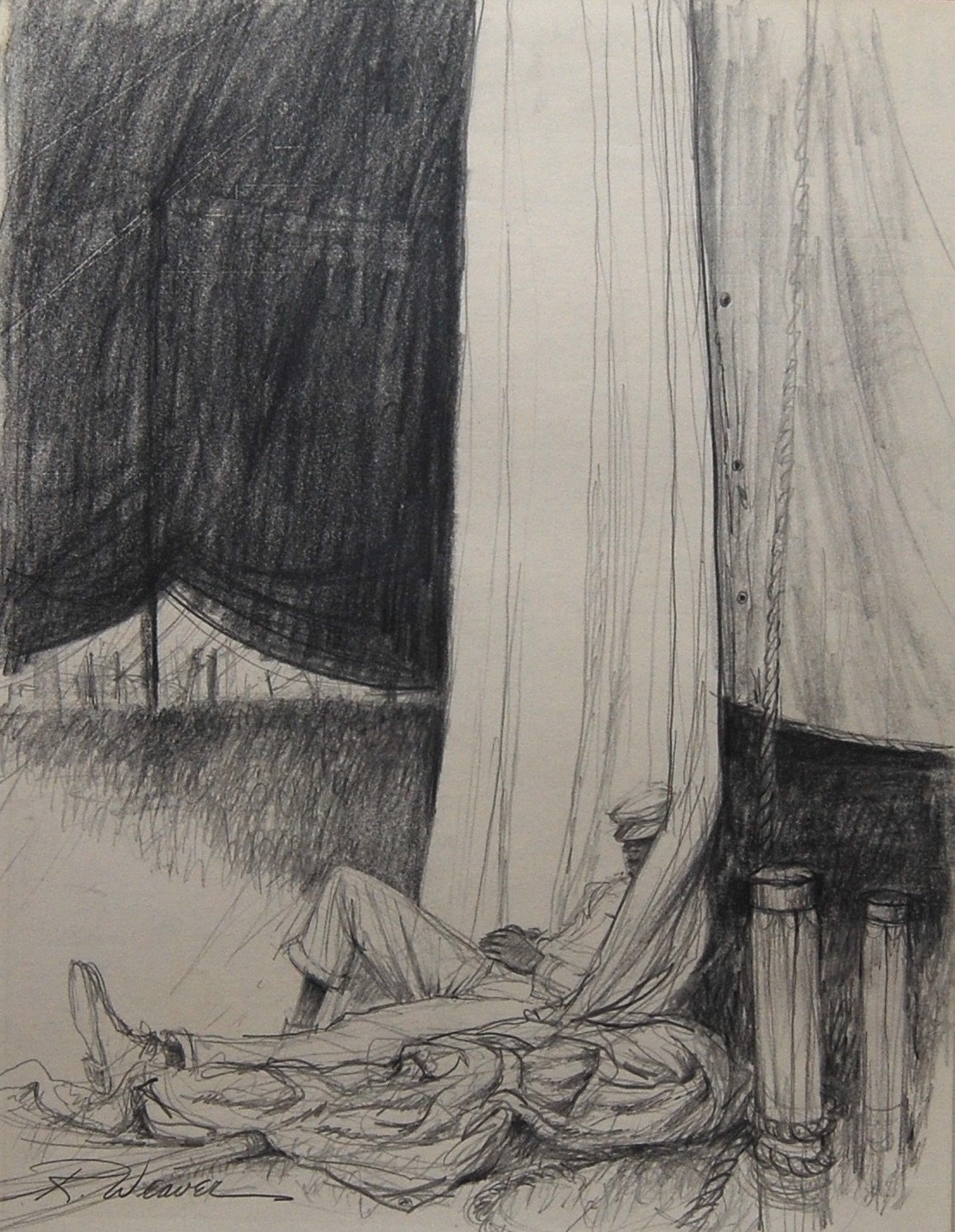
Graphite pencil on paper.

This charcoal and pencil drawing was a study for a finished painting by REW. It dates to the period that he was working in New York City in the 1930's. The finished painting sold at Sotheby's Auction House in the fall of 2014.

Charcoal and graphite pencil on velum. 17 x 14 inches. Study for a future work. #358
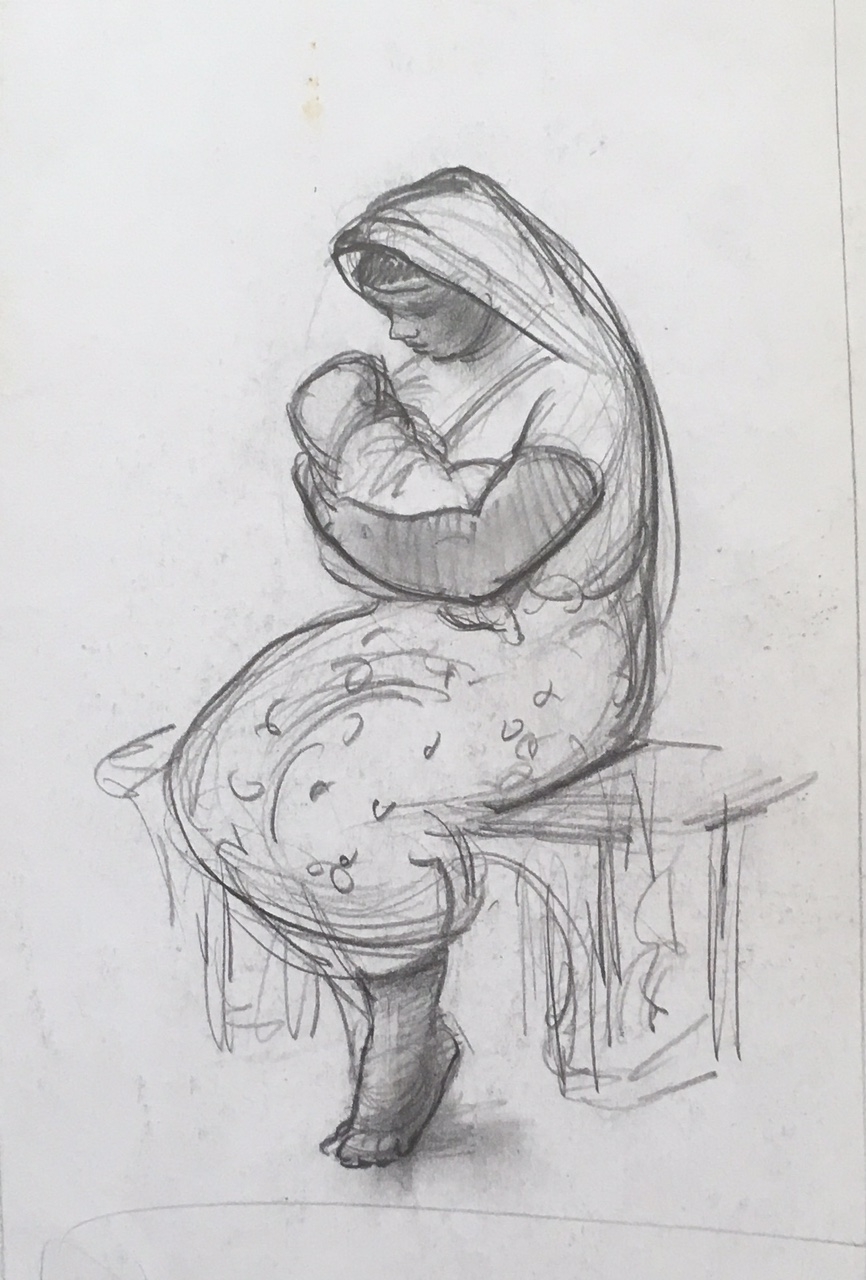
Graphite pencil on heavy paper. This is a rare study by REW done in Mexico while still fulfilling his overseas study as a result of winning the 1937 Chaloner Prize. This most likely was executed in Guadalajara. The influence of his European study of Madonnas in the great museums of France undoubtably informed this work. #620

Graphite pencil on heavy paper. This sketch is most likely attributable to REW's time in New York City or Paris. #612

Graphite pencil on heavy paper. Executed during REW's study in France. REW was interested in illustrating everyday people working in their environments in his compositions. #613

Graphite pencil on heavy paper. Unframed, unmatted. This sketch is an essay on choice of lifestyle done by REW when he was in London as part of his Chaloner Prize obligation. #617

Graphite on paper, 14” x 10.5” unsigned, estate stamp and provenance on reverse. This is a study for the finished painting #9, “Emmett Kelly reading the Wall Street Journal.” #327 (private collection)
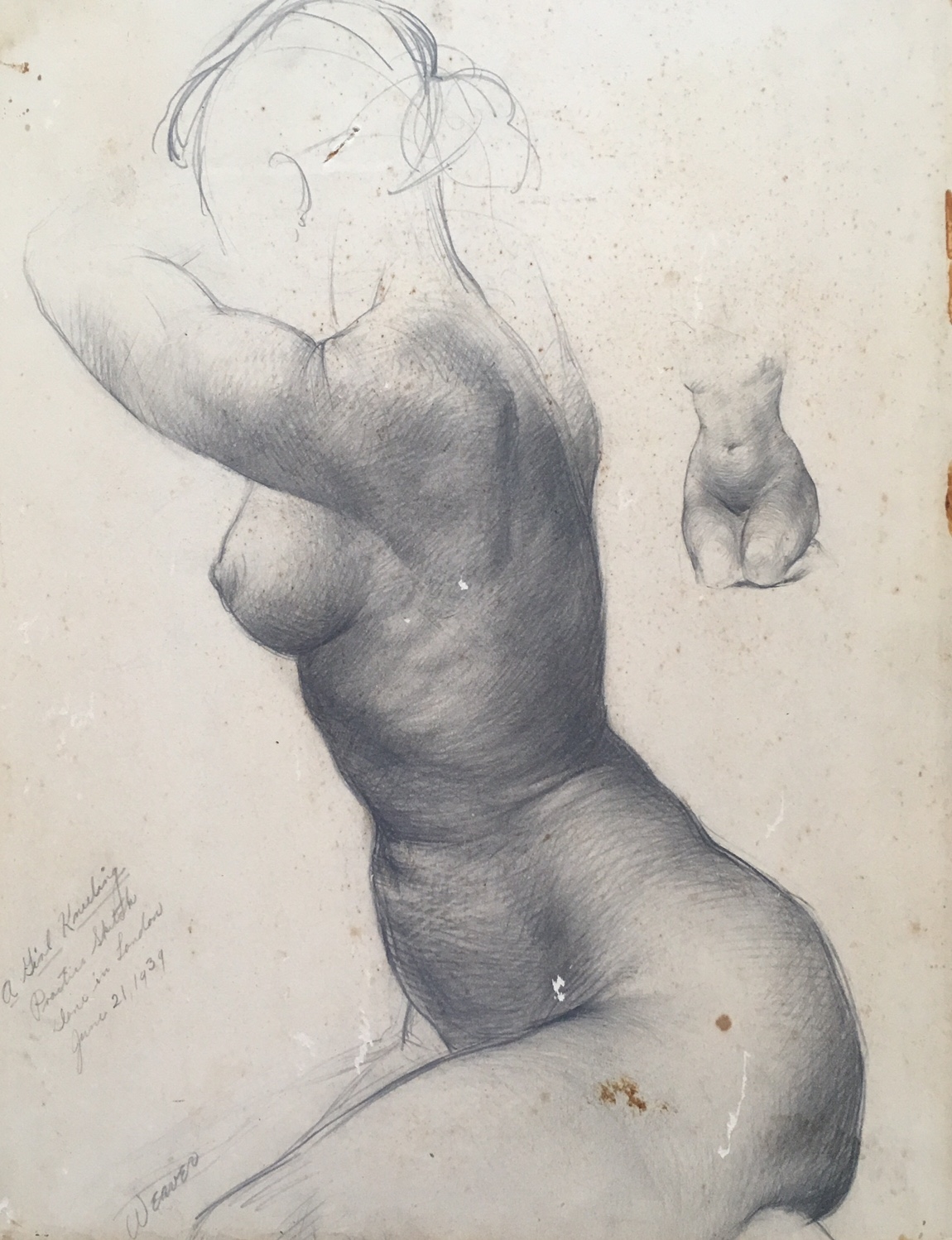
Graphite pencil on heavy paper. A rare London, UK work. This work is inscribed on the drawing lower left. "A Girl Kneeling, Practice Sketch, Done in London, June 21, 1939." The drawing demonstrates REW's great ability to draw the human figure. #619

Graphite pencil on paper. When REW was in Paris during summer of 1939 he made several sketches of Parisian life. This drawing was amongst a portfolio from that time. #614
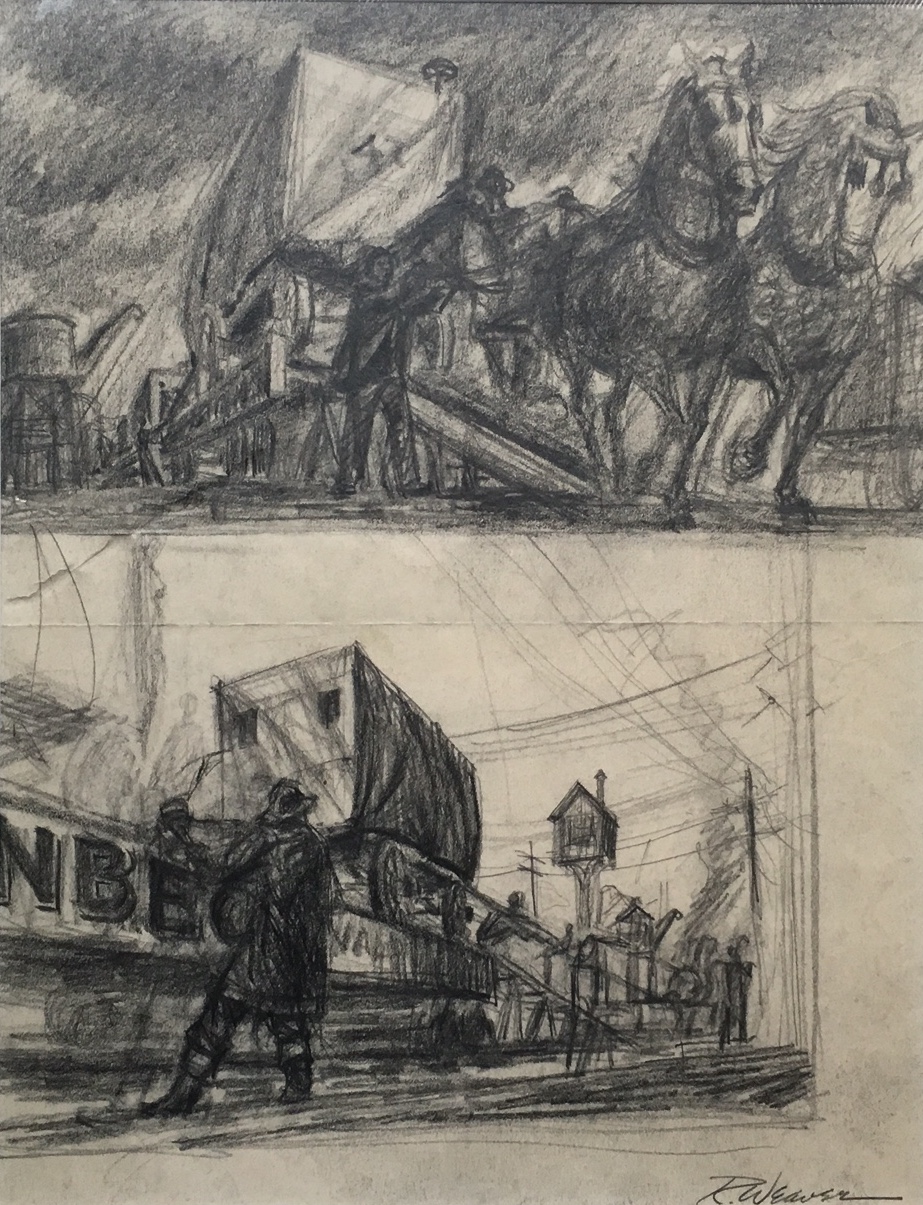
Graphite on paper. 14 x 11 inches. Signed R. Weaver lower right. Even in the heavy rain, circus wagons were unloaded to get the show set-up and ready for the day’s performances. The blowing tarps and powerful equines of the Hagenbeck-Wallace Circus give this composition great motion and depth. Two things REW was known to capture in his compositions. This is a relatively early study from a sketchbook by REW. This is a very strong drawing by REW. #406 (collection of Darrell Mitchell)

Graphite pencil on paper. 14 x 10.5 inches. Signed R. Weaver lower right. Unframed, matted. As a boy it was an experience like this one, great horses pulling a Great Wallace Circus wagon that inspired REW for the rest of his creative life. This is a detail study for lithograph print #180 by REW. #238
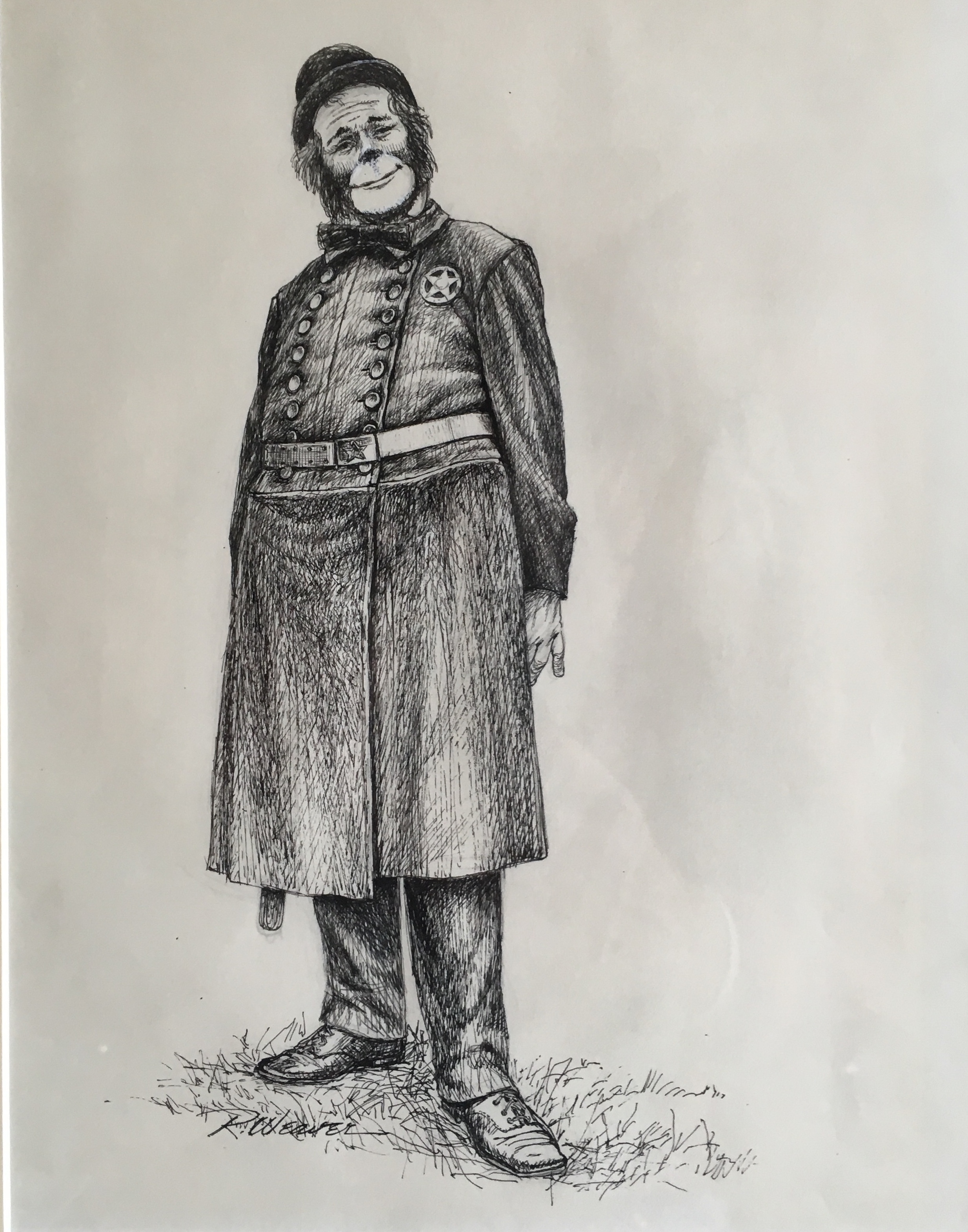
Pen and ink on paper. 12 x 9.5 inches. Unframed, matted, shrink wrapped. Signed R. Weaver lower left. This finished ink drawing by REW depicts the great circus clown Doc Kieley. This was a study for a large format fully realized painting #57. #276

Pen and ink, with watercolor on paper. 12 x 9.5 inches. Signed R. Weaver lower right. The great Edwin Richard "Poodles" Hanneford was a friend, and greatly admired performer of REW's. He is the subject of many works by REW great and small. REW considered him the greatest bare-back rider of all time. #277

Graphite pencil on paper. Signed R. Weaver lower right. #289
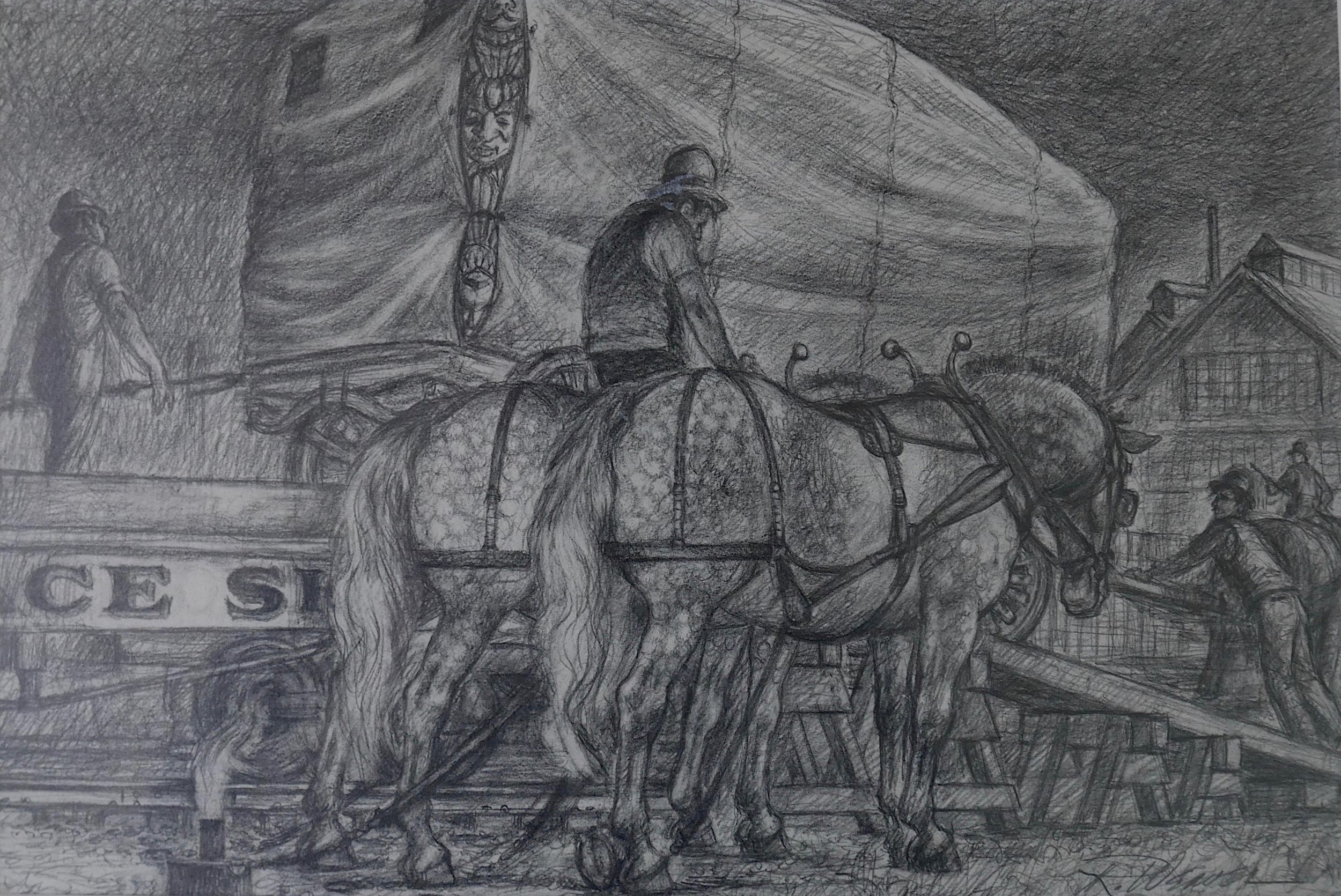
Graphite pencil on paper. Signed R. Weaver lower right. #393










































Graphite pencil on Illustration Board. 48 x 25 inches. This is the full sized pencil drawing for the finished painting now in the collection of John Mecom, Jr. The subject matter is famed racing driver Wilbur Shaw staving off one of his rivals. In this case, Charles "Dutch" Bauman. This work is fully matted and framed. (private collection). #60
Graphite pencil/charcoal on board. 58.125 x 40.125 inches. Full size drawing for the fully realized painting that tied for first place in the 1937 Chaloner Prize competition. #39
Graphite on paper, 30.5” x 22.625” signed R. Weaver lower right. This drawing was for the recently rediscovered painting by REW is typical of his style post WWII. The subjects on horseback are most likely Edwin “Poodles” Hanneford and his daughter Gracie. The composition perfectly illustrated his youthful enthusiasm for the illustrating the circus of the 1930s and early 40s. See the finished painting in the painting menu. (private collection of Philip Keller)
Graphite pencil on paper. 10 x 15 inches. Signed lower right R. Weaver. Unframed, matted and shrink wrapped. Nothing on the circus lot was more exciting to REW than watching the great Big Top go up. Here five workers, lead by the Boss Canvas Man, raise side poles, and fix the lines to stakes. #396
Graphite on paper, mounted on foam board. 38” x 29,” signed R. Weaver lower left. Perhaps one of the last large drawings completed by REW before his passing in 1991. John Bill Ricketts is considered to be the father of the American circus. He was the first in the United States to combine equestrian, acrobats, trained animals, and clowns in one show. Ricketts’ circus opened on April 3, 1793 with President George Washington in attendance. #192
Graphite, on paper. 11 inches x 14 inches. Signed R. Weaver lower right. Once in a while REW would deviate from his usual subject matter to illustrate a moment or event. One of those events was the visit by hurricane Gloria in 1985, one of his first years living in North Carolina. This drawing was a study for the final painting. The painting sold but this drawing is still available for purchase. W84A
Lithograph print on cover stock paper. In the mid-1970s, REW produced limited edition prints of some of the great circus wagons of the early days of the traveling shows. They were referred to as
”Cottage Wagons” because of their ornate decoration, including bays, and ornate roof decorations. Copies of this print are available for purchase.
Graphite pencil on paper. Signed R. Weaver lower left. #217
Graphite pencil on illustration board. Signed R. Weaver lower right. REW was known for his drafting skills. His knowledge of anatomy was so sound that he rarely if ever used models beyond school. #W81
Graphite pencil on board. #W178
Graphite on paper. 10.5 x 14.75 inches. Matted and signed R. Weaver lower right. Exhausted "roustabouts" nap on the tongue of wagons. The tongue was the piece of equipment that horses were hitched to to pull the great circus wagons to there destinations. #403 (private collection)
Graphite pencil on paper. 13 x 9.25 inches. Signed R. Weaver lower left. Unframed, matted, and shrink wrapped. The blacksmith helped to keep everything running on the circus compound. The forge ran endlessly during the circus's stay in any town. Of course, he always had time for a beautiful performer that might stroll by. #422
Graphite on illustration board. Signed R. Weaver lower right. The subject is self explanatory and demonstrates REW’s great ability as an illustrator. Represented by James R. Ross Fine Art #158
Graphite on card stock, 11 x 14.125 inches, unsigned, estate stamped on the reverse side. Matted. A principal figure on any traveling circus was the Side Show barker. The barker's combination of wit and oratory guided patrons to the Side Show to see and experience the unusual. This is an early work by REW that demonstrates his great sense of figural composition.
Graphite pencil on Illustration board. This image captures the fascination of the young girl with a favorite souvenir from the circus. #150
Graphite pencil on paper. Never straying too far from his love of circus, REW made this study of an aerialist in his dressing tent. It is very similar in composition to his "Circus Girl In Her Dressing Tent." (see paintings on this website) The subject here is Robert Porter, one of the great circus horizontal bar artists of his time. #597
Artist pencil on paper. Unframed, unsigned, matted in shrink wrap. Estate stamp on reverse. 8 x 13 inches. This early study by REW looks at a midwestern fair ground, and one of its more popular competitions. The horse pull. The study illustrates the power of equines guided by their equally strong master. REW had a great affinity for equestrian subjects both circus and civilian. #392
Graphite pencil, on paper. unsigned. 13"x 9 3/4." Circus performers gather around a stove in a rehearsal barn amidst the banners. Fully matted and framed in American chestnut 22 5/8"x 19 1/8." #225
Graphite pencil on paper. 12.5 x 10.5 inches. Signed R. Weaver lower right. Unframed, matted, and shrink wrapped. Circus roustabouts rest on hay bales waking to the cookhouse smoke. Sometimes food and a place to sleep were the pay on the traveling circus. #270
Early study by Robert Edward Weaver. Possibly Joe Louis. (unsigned) #606
Unsigned early work by Robert Edward Weaver. #621A
Graphite pencil and ink guache on paper. #571
Graphite pencil on illustration board.
Graphite pencil on illustration board. A work of whimsy by REW. During the mid-1970's REW was working on ideas for a children's book. This was one of the many puny images that REW concocted out of his fertile brain at the time.
Graphite pencil on heavy stock. (unsigned)
Another rare work from WWII by Robert Edward Weaver. #W232
Graphite pencil on paper.
This charcoal and pencil drawing was a study for a finished painting by REW. It dates to the period that he was working in New York City in the 1930's. The finished painting sold at Sotheby's Auction House in the fall of 2014.
Charcoal and graphite pencil on velum. 17 x 14 inches. Study for a future work. #358
Graphite pencil on heavy paper. This is a rare study by REW done in Mexico while still fulfilling his overseas study as a result of winning the 1937 Chaloner Prize. This most likely was executed in Guadalajara. The influence of his European study of Madonnas in the great museums of France undoubtably informed this work. #620
Graphite pencil on heavy paper. This sketch is most likely attributable to REW's time in New York City or Paris. #612
Graphite pencil on heavy paper. Executed during REW's study in France. REW was interested in illustrating everyday people working in their environments in his compositions. #613
Graphite pencil on heavy paper. Unframed, unmatted. This sketch is an essay on choice of lifestyle done by REW when he was in London as part of his Chaloner Prize obligation. #617
Graphite on paper, 14” x 10.5” unsigned, estate stamp and provenance on reverse. This is a study for the finished painting #9, “Emmett Kelly reading the Wall Street Journal.” #327 (private collection)
Graphite pencil on heavy paper. A rare London, UK work. This work is inscribed on the drawing lower left. "A Girl Kneeling, Practice Sketch, Done in London, June 21, 1939." The drawing demonstrates REW's great ability to draw the human figure. #619
Graphite pencil on paper. When REW was in Paris during summer of 1939 he made several sketches of Parisian life. This drawing was amongst a portfolio from that time. #614
Graphite on paper. 14 x 11 inches. Signed R. Weaver lower right. Even in the heavy rain, circus wagons were unloaded to get the show set-up and ready for the day’s performances. The blowing tarps and powerful equines of the Hagenbeck-Wallace Circus give this composition great motion and depth. Two things REW was known to capture in his compositions. This is a relatively early study from a sketchbook by REW. This is a very strong drawing by REW. #406 (collection of Darrell Mitchell)
Graphite pencil on paper. 14 x 10.5 inches. Signed R. Weaver lower right. Unframed, matted. As a boy it was an experience like this one, great horses pulling a Great Wallace Circus wagon that inspired REW for the rest of his creative life. This is a detail study for lithograph print #180 by REW. #238
Pen and ink on paper. 12 x 9.5 inches. Unframed, matted, shrink wrapped. Signed R. Weaver lower left. This finished ink drawing by REW depicts the great circus clown Doc Kieley. This was a study for a large format fully realized painting #57. #276
Pen and ink, with watercolor on paper. 12 x 9.5 inches. Signed R. Weaver lower right. The great Edwin Richard "Poodles" Hanneford was a friend, and greatly admired performer of REW's. He is the subject of many works by REW great and small. REW considered him the greatest bare-back rider of all time. #277
Graphite pencil on paper. Signed R. Weaver lower right. #289
Graphite pencil on paper. Signed R. Weaver lower right. #393